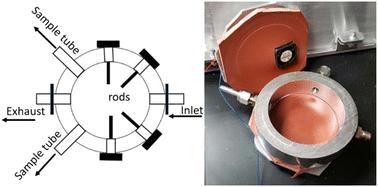当前位置:
X-MOL 学术
›
Environ. Sci.: Processes Impacts
›
论文详情
Our official English website, www.x-mol.net, welcomes your feedback! (Note: you will need to create a separate account there.)
A rapid micro chamber method to measure SVOC emission and transport model parameters
Environmental Science: Processes & Impacts ( IF 5.5 ) Pub Date : 2023-03-10 , DOI: 10.1039/d2em00507g Chunyi Wang 1 , Clara M A Eichler 1, 2 , Chenyang Bi 1 , Christiaan J E Delmaar 3 , Ying Xu 4 , John C Little 1
Environmental Science: Processes & Impacts ( IF 5.5 ) Pub Date : 2023-03-10 , DOI: 10.1039/d2em00507g Chunyi Wang 1 , Clara M A Eichler 1, 2 , Chenyang Bi 1 , Christiaan J E Delmaar 3 , Ying Xu 4 , John C Little 1
Affiliation

|
Assessing exposure to semivolatile organic compounds (SVOCs) that are emitted from consumer products and building materials in indoor environments is critical for reducing the associated health risks. Many modeling approaches have been developed for SVOC exposure assessment indoors, including the DustEx webtool. However, the applicability of these tools depends on the availability of model parameters such as the gas-phase concentration at equilibrium with the source material surface, y0, and the surface–air partition coefficient, Ks, both of which are typically determined in chamber experiments. In this study, we compared two types of chamber design, a macro chamber, which downscaled the dimensions of a room to a smaller size with roughly the same surface-to-volume ratio, and a micro chamber, which minimized the sink-to-source surface area ratio to shorten the time required to reach steady state. The results show that the two chambers with different sink-to-source surface area ratios yield comparable steady-state gas- and surface-phase concentrations for a range of plasticizers, while the micro chamber required significantly shorter times to reach steady state. Using y0 and Ks measured with the micro chamber, we conducted indoor exposure assessments for di-n-butyl phthalate (DnBP), di(2-ethylhexyl) phthalate (DEHP) and di(2-ethylhexyl) terephthalate (DEHT) with the updated DustEx webtool. The predicted concentration profiles correspond well with existing measurements and demonstrate the direct applicability of chamber data in exposure assessments.
中文翻译:

一种快速测量 SVOC 排放和传输模型参数的微室方法
评估室内环境中消费品和建筑材料排放的半挥发性有机化合物 (SVOC) 的暴露情况对于降低相关健康风险至关重要。已经为室内 SVOC 暴露评估开发了许多建模方法,包括 DustEx 网络工具。然而,这些工具的适用性取决于模型参数的可用性,例如与源材料表面平衡的气相浓度y 0和表面-空气分配系数K s,这两者通常都是在室内实验中确定的。在这项研究中,我们比较了两种类型的腔室设计,一种是大腔室,它将房间的尺寸缩小到较小的尺寸,表面体积比大致相同,另一种是微型腔室,它最大限度地减少了水槽到-源表面积比,以缩短达到稳定状态所需的时间。结果表明,对于一系列增塑剂,具有不同汇源表面积比的两个腔室产生相当的稳态气相和表面相浓度,而微腔室达到稳态所需的时间明显更短。使用微室测量的y 0和K s ,我们对 din - n进行了室内暴露评估邻苯二甲酸丁酯 (D n BP)、邻苯二甲酸二(2-乙基己基)酯 (DEHP) 和对苯二甲酸二(2-乙基己基)酯 (DEHT),使用更新的 DustEx 网络工具。预测的浓度分布与现有测量结果很好地对应,并证明了腔室数据在暴露评估中的直接适用性。
更新日期:2023-03-10
中文翻译:

一种快速测量 SVOC 排放和传输模型参数的微室方法
评估室内环境中消费品和建筑材料排放的半挥发性有机化合物 (SVOC) 的暴露情况对于降低相关健康风险至关重要。已经为室内 SVOC 暴露评估开发了许多建模方法,包括 DustEx 网络工具。然而,这些工具的适用性取决于模型参数的可用性,例如与源材料表面平衡的气相浓度y 0和表面-空气分配系数K s,这两者通常都是在室内实验中确定的。在这项研究中,我们比较了两种类型的腔室设计,一种是大腔室,它将房间的尺寸缩小到较小的尺寸,表面体积比大致相同,另一种是微型腔室,它最大限度地减少了水槽到-源表面积比,以缩短达到稳定状态所需的时间。结果表明,对于一系列增塑剂,具有不同汇源表面积比的两个腔室产生相当的稳态气相和表面相浓度,而微腔室达到稳态所需的时间明显更短。使用微室测量的y 0和K s ,我们对 din - n进行了室内暴露评估邻苯二甲酸丁酯 (D n BP)、邻苯二甲酸二(2-乙基己基)酯 (DEHP) 和对苯二甲酸二(2-乙基己基)酯 (DEHT),使用更新的 DustEx 网络工具。预测的浓度分布与现有测量结果很好地对应,并证明了腔室数据在暴露评估中的直接适用性。



























 京公网安备 11010802027423号
京公网安备 11010802027423号